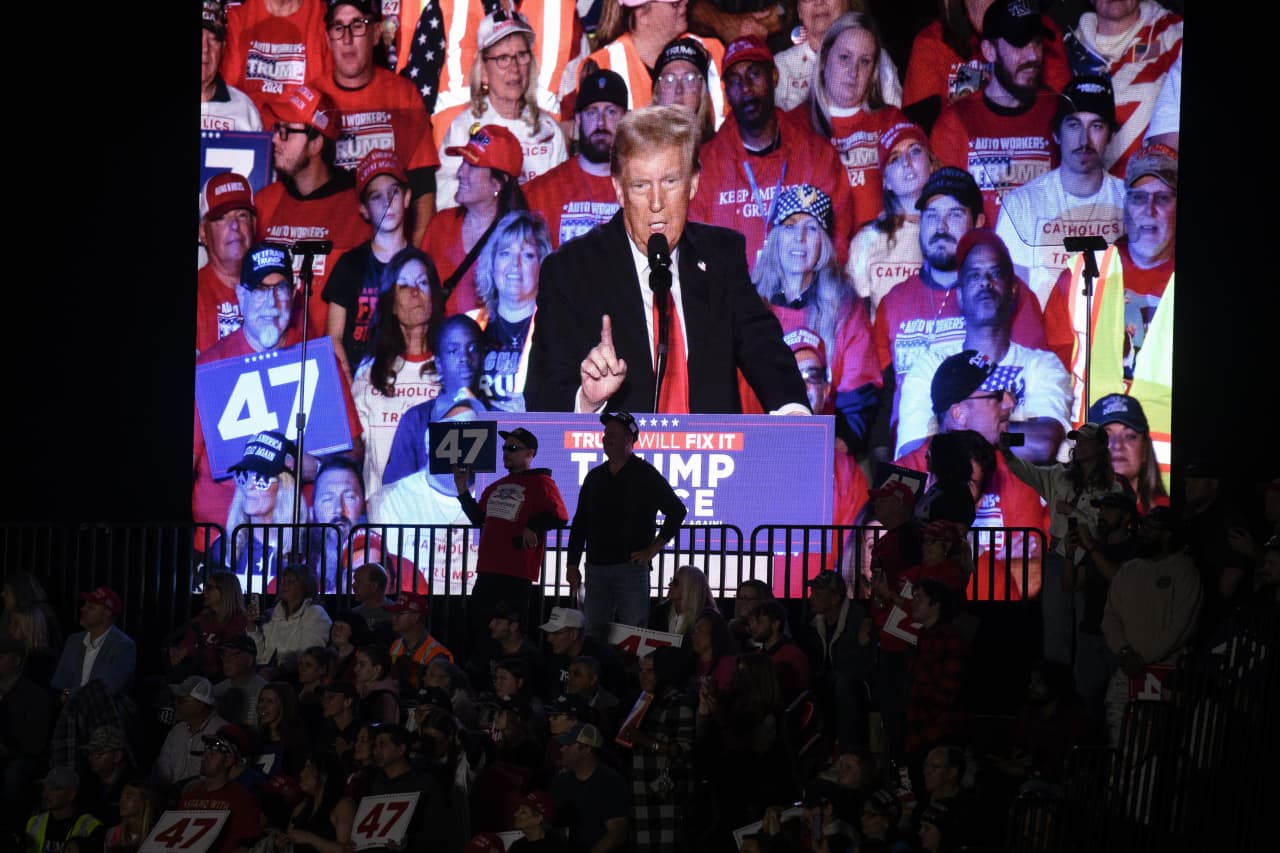WARREN, Mich.— Donald Trump had been speaking for more than an hour and a half when he got to the point.
“For the past nine years, we have been fighting against the most sinister and corrupt forces on earth,” the former president said, as the crowd seated on folding chairs in the cavernous community-college arena murmured its assent. “With your vote in this election, you can show them once and for all that this nation does not belong to them—this nation belongs to you.”
As Trump and his opponent, Vice President Kamala Harris , make their final pitches to a divided nation, Trump’s essential argument has changed remarkably little over the course of three presidential campaigns: that the system is rigged and foreign invaders threaten the nation. What has changed is the context, as Trump’s decadelong dominance of American politics has rearranged the electorate in response. Now, an election that stands on a knife’s edge is poised to settle the central question—whether a discontented country will endorse or reject another installment of his destabilizing vision.
Trump’s third and seemingly final campaign is a bet that more Americans have warmed to this central argument in this age of distrust and dissatisfaction. The thousands who had come to see him on Friday afternoon in this blue-collar Detroit exurb cheered as he railed against elites and foreigners. “We will not be invaded, we will not be occupied, we will not be overrun, we will not be conquered,” he said. “We will be a free, proud nation once again!”
There are signs his argument is resonating. High inflation and chaos at the southern border—both of which the current administration belatedly took steps to address after being exacerbated by its policies—have drawn attention to his signature issues of the economy and immigration. Polls show he is more popular than ever, though still unpopular on balance, and many remember his tumultuous presidency fondly. The national and swing-state surveys, which broadly show Trump and Harris locked in a tie, represent his best pre-election polling position to date, as his campaign pollster Tony Fabrizio pointed out in a memo last week: ”President Trump’s position nationally and in every single Battleground State is SIGNIFICANTLY better today than it was 4 years ago,” Fabrizio wrote.
At the very least, the years since Trump left office—on the heels of the Jan. 6, 2021, Capitol riot—have, far from delivering the wholesale public rejection that his opponents craved, indicated an enduring appetite for his disruptive political style. To be sure, Democrats believe that Trump’s lack of discipline and dark, violent message are costing him votes in the campaign’s final days, particularly with women . A Harris campaign official said Friday that the campaign’s data shows late-deciding voters moving sharply in her direction.
Still, the public’s dissatisfaction with the status quo has continued to move new voters into Trump’s camp. One attendee at his Friday rally in Warren was Kathy Wright , a 70-year-old Sterling Heights resident who runs a cleaning business. She voted for President Biden four years ago because he “seemed like a nice guy” and she was put off by Trump’s demeanor. “Now I can’t stand him,” she said of Biden, and she believes Trump will fix the economy and the border. “This whole country, everything’s crooked,” she said. “It’s so corrupt, it’s sickening.”
Roque Diegel , a 59-year-old military retiree from Henderson Township, wore a TRUMP VS. EVERYBODY T-shirt. “I was a union Democrat for a long time. My family all worked in the auto industry,” he said. “There’s been so many false accusations against this guy for so many years, why would he not be fighting against everybody? He fights the establishment to a standstill and then keeps going. Most people would have given up, but he’s not going to do that.”
It was his appeal to voters like these that propelled Trump to his shock victory in 2016. White working-class voters shifted seismically in his direction—and came out in droves—powering his narrow victories in the Midwestern states where those voters are disproportionately represented, such as Michigan, Wisconsin and Pennsylvania.
Macomb County, where Warren is located, was illustrative. In the 1980s, it was the subject of a famous study by the Democratic pollster Stan Greenberg , who found that “Reagan Democrats”—working-class white voters—were switching to the GOP out of a sense of cultural alienation. Barack Obama won Macomb twice. But in 2016 and 2020, Trump won the county on the strength of those same forces. Biden narrowly won Michigan in 2020; the polling average maintained by FiveThirtyEight currently has Harris ahead of Trump in the state by a 1-point margin.
“This is the county that put Donald Trump over the top in 2016,” Brian Pannebecker , the head of Auto Workers for Trump 2024, told the crowd. “Now we’re going to do it again.” He said he had spent the past five months holding rallies and speaking with workers outside every auto plant in the Detroit area as job losses continued. Chrysler parent company Stellantis laid off more than 1,000 workers at its plant in Warren in October, and Ford announced last week that it will shut down a plant in nearby Dearborn later this month.
Trump’s appeal to the disaffected, the conspiratorial, the down and out, has broadened over the intervening years to include a substantial tranche of working-class minority voters as well as whites without college degrees, particularly men. His campaign this year is betting there are still more of these voters to be drawn off the sidelines. “The share of white noncollege voters that support Democrats has been declining since the 1970s, but Trump dramatically accelerated the trend,” said Matt Grossmann, a political scientist at Michigan State University and author of a recent book on the growing gulf between voters with and without college degrees.
But Trump also galvanized a countervailing force—a tide of college-educated voters who mobilized in opposition to him after his initial win. Biden’s 2020 victory came not primarily from winning back working-class whites but from an equally seismic shift among educated suburban voters, especially women—an effect that Democrats expect to be even more pronounced in this first presidential election since the Supreme Court’s 2022 decision overturning Roe v. Wade. Onetime GOP strongholds such as the Detroit suburbs and the area around Grand Rapids have swung to the Democrats. Michigan’s population is becoming more educated over time, Grossmann noted, meaning there are more of those voters for Democrats to draw from in each successive election.
If Trump wins, it will be because he managed to drive up his margins with disaffected working-class voters nationally. But if he loses, it will be because even more educated suburban voters came out to oppose him. Michigan Democrats have staged a remarkable comeback since 2016, retaking the governorship and both houses of the state legislature behind the popular Democratic Gov. Gretchen Whitmer and an all-female team of statewide officeholders. “Yes, abortion rights are important,” said Democratic state Sen. Mallory McMorrow . “But it’s about character and it’s about so much more than that.” In her canvassing of the state, McMorrow said, women tell her they are “voting for Democrats up and down the ballot because we want to move on” from Trump.
In Stockbridge, Mich., a small village between Detroit and Lansing, 66-year-old business owner Jackie Scheller echoed that sentiment. A lifelong Republican and Michigan native, Scheller voted for Trump twice. But her faith was shaken by Jan. 6, and she began to reconsider. Now Scheller is all-in for Harris, lobbying her friends and neighbors, placing ads in her local paper, and appearing in videos and billboards for the national group Republican Voters Against Trump. (The group said last week it has placed more than 150 billboards along major roadways in Michigan, Wisconsin and Pennsylvania, featuring former Trump voters who support Harris—part of a more than $40 million investment in defeating the former president.)
“I just can’t put someone into office who is doing what Trump is doing any longer,” Scheller said. “Trump lost me primarily at the insurrection, but there were other things. I’m looking forward to a time when I don’t have to get up every morning and find out what bombastic thing he did while I was sleeping.”
Harris’s campaign has done its best to court voters like Scheller, spotlighting the vice president’s support from Republicans, such as former Rep. Liz Cheney , and arguing that she will govern from the center and bring Americans together. Her campaign is projecting confidence in the election’s final days, while Trump’s message has been muddled by distractions, from vowing to protect women “whether they like it or not” to calling for Cheney to face live fire in battle. Speaking in Pennsylvania on Sunday, Trump said he wouldn’t mind if an assassin had to shoot through the media to get to him.
On Tuesday, Harris delivered a speech intended to encapsulate her closing argument from an evocative location in Washington: the Ellipse, where Trump spoke on Jan. 6 to the mob that would proceed to storm the Capitol as it sought to interrupt the official tabulation of electoral votes confirming his election loss. She was preceded on the program by a series of speakers—a Texas couple denied an abortion for a nonviable pregnancy, a single mom of a child with diabetes, a Phoenix small business-owner, a Republican couple from Pennsylvania, the brother of a Capitol Police officer who died after Jan. 6—each of whose remarks included a plea to “turn the page on Donald Trump.”
The crowd of 75,000 waved miniature American flags as Harris spoke before giant banners reading “FREEDOM” and “USA.” “Look, we all know who Donald Trump is,” she said. “He is the person who stood at this very spot nearly four years ago and sent an armed mob to the United States Capitol to overturn the will of the people in a free and fair election that he knew he lost.”
To a greater degree than Biden or Hillary Clinton , Harris has tried to weave together her argument against Trump’s character and chaos with a pitch for voters’ pocketbooks—the upshot of a heated behind-the-scenes argument among Democrats over whether to emphasize Trump’s alleged threat to democracy or the less abstract concerns that tend to motivate rank and file voters. The synthesis is distilled in a line that has become the centerpiece of her speeches: “If elected, Donald Trump would walk into that office with an enemies list. When elected, I will walk in with a to-do list full of priorities on what I will get done for the American people.”
To the ecstatic but anxious crowd gathered in Washington, that was a welcome message. “One of the worst days in the history of our country was Jan. 6, and it started here. Hopefully this is the ending of that period, and we go forward from here with a new vision,” said Thomas Tracy , a 69-year-old retired bond analyst from Bloomington, Minn. A former Republican, he said he was perplexed by the closeness of the polls given what he viewed as a healthy economy.
Debra Wilhelm , a 70-year-old retired teacher from Loxahatchee, Fla., said she viewed Jan. 6 as a national tragedy akin to 9/11. “It was an attack on our constitution, an attack on America, and from within,” she said. As the sun set over the Washington Monument behind her, she said she feared particularly for her granddaughters if Trump regained the presidency. “It’s not the America we grew up in,” she said.
Harris has wagered that more people are tired of the Trump Show than thrilled by it—that America’s true silent majority are the voters who simply want to put his divisive, destabilizing dominance of the political system behind them. In a few days, we will learn whether she is right.
Write to Molly Ball at molly.ball@wsj.com



